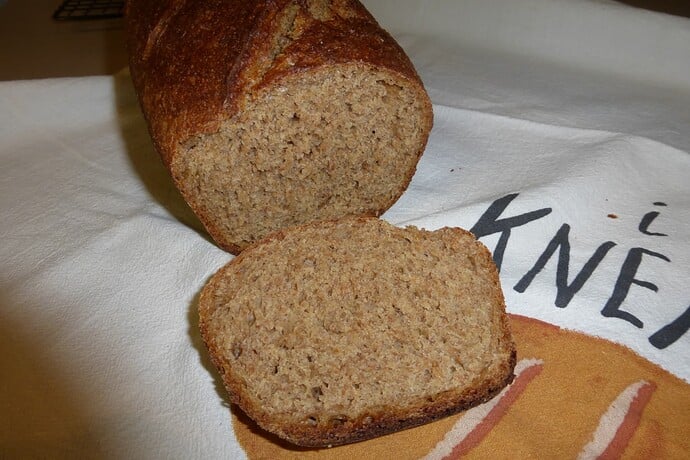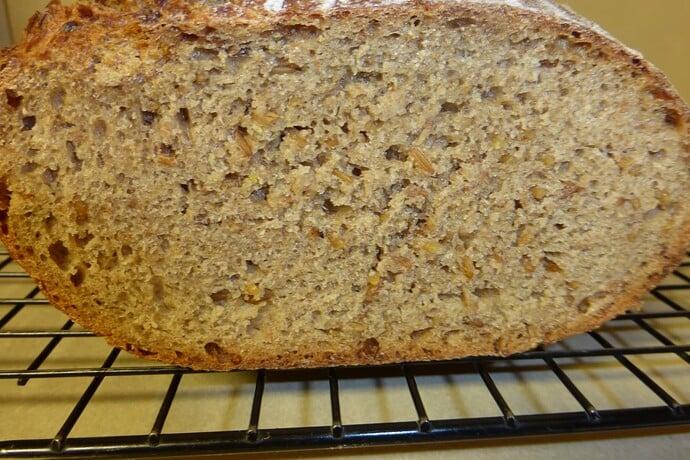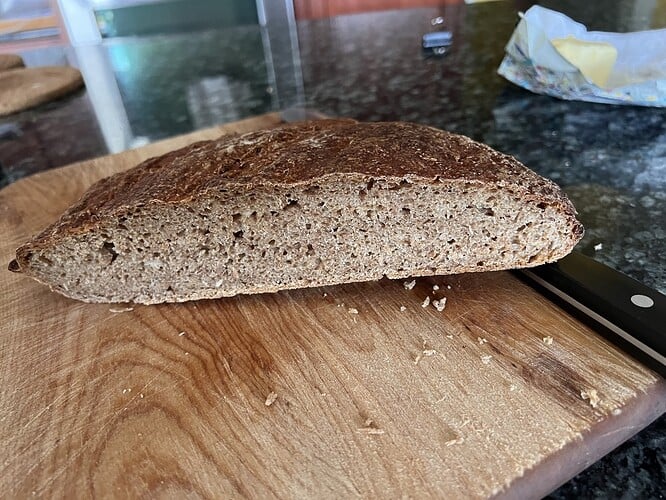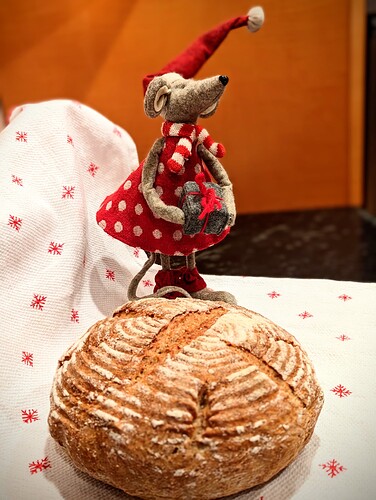When I first discovered Kernza, I purchased a few bags and tried it with a few adaptations of my recipes. My only “disappointment” was the attempt to sprout some Kernza berries - the result was about 50% germination. The following are the recipes that worked for me. I also posted these on the Perennial Pantry website.
Kountry Kernza
Yield: 1 two-pound loaf of bread
Time: 12 to 24 hours, depending on how the dough is proofed
Ingredients:
350 grams water
100 grams Kernza flour
400 grams All Purpose flour
75 grams ripe sourdough starter
9 grams sea salt
Equipment:
Kitchen scale
Proofing basket (optional)
Cloche or Dutch oven (or other suitable baking vessel)
Thermometer
Instructions:
- Mix together 350 grams of water, 100 grams Kernza and 250 grams AP flour, let stand for 2 hours (the autolyze).
- Blend 75 grams of ripe sourdough starter into the previous mixture.
- Mix the salt into the remaining AP flour (150 grams) and blend into the dough. Mix until the flour is completely incorporated. Cover and let stand for 30 minutes.
- Do a series of 4 or 5 “stretch & folds” at 30 minute intervals, resting the dough in between.
- Cover and let the dough stand at room temperature for an additional 2 to 4 hours. Then refrigerate the dough and bulk ferment for another 12 hours. During the bulk ferment, the dough should about double in volume.*
- Remove the dough from the refrigerator, degas the dough and shape the dough. Place the dough into a proofing basket that has been dusted with rice flour. Cover and let stand for about an hour or until the dough has doubled in volume.
- Place the cloche in the oven. Preheat the oven to 450 degrees F.
- Remove the pre-heated base of the cloche from the oven, place the dough onto the base, cover and return to the oven for 25 minutes.
- Remove the cloche cover and bake for an additional 20 minutes.** The bread is done when the internal temperature reaches 200 to 205 degrees F.***
Additional comments:
I have been baking sourdough bread for several years. Most of the bread that I bake use a blend of flours with a preponderance of whole grain flours. I use some Kamut, an heirloom variety of wheat, in most of my breads. I decided to experiment with the 21st Century variety – Kernza.
To get a sense for how Kernza performs, I decided to begin with a basic sourdough recipe, a variation on the Sourdough Country Loaf recipe in Tartine Bread. This recipe is an adaptation that substitutes Kernza for the whole wheat flour.
*Timing for the bulk ferment is variable, depending on the temperature at which the dough is proofed. Refrigeration retards the process. Proofing time would be shorter if the dough is proofed at warmer than room temperature.
**If a softer crust is desired, increase the covered baking time
***Baking times will vary, depending on oven performance.
As an alternative to leavening the dough with sourdough starter, the home baker could use a poolish. Mix together 100 grams of water, 100 grams of AP flour and ¼ teaspoon active yeast. Let stand for about 12 hours. Then, add ¼ teaspoon active yeast, the remainder of the water and flour and the salt. Continue with the stretch & folds. Complete the bulk fermentation at room temperature and shape the dough after the dough has doubled in volume.
Honey Kernza Loaf
Yield: 1 two-pound loaf of bread
Time: 12 to 24 hours, depending on how the dough is proofed
Ingredients:
200 grams water (3/4 cup + 1 T)
180 grams scalded milk (3/4 cup + 1 T)
200 grams Kernza flour (1 3/4 cup)
100 grams whole wheat flour (7/8 cup)
200 grams All Purpose flour (1 3/4 cup)
30 grams honey (2 T)
2 T unsalted butter
75 grams ripe sourdough starter (1/3 cup)
9 grams sea salt (1 t)
Equipment:
Kitchen scale
Instructions:
- Heat milk to 180 degrees
- Melt the butter with the honey and add to the scalded milk.
- Add the water to the milk mixture.
- After the milk mixture has cooled to lukewarm temperature, stir in the Kernza; whole wheat and 100 grams of AP flour. Let stand for 2 hours.
- Blend 75 grams of ripe sourdough starter into the previous mixture.
- Mix the salt into the remaining AP flour (100 grams) and blend into the dough. Mix until the flour is completely incorporated. Cover and let stand for 30 minutes.
- Do a series of 4 or 5 “stretch & folds” at 30 minute intervals, resting the dough in between.
- Cover and let the dough stand at room temperature for an additional 2 to 4 hours. Then refrigerate the dough and bulk ferment for another 12 hours. During the bulk ferment, the dough should about double in volume.
- Remove the dough from the refrigerator, degas the dough and shape the dough. Place the dough into a lightly oiled and dusted loaf pan. Cover and let stand for about an hour, until the dough has doubled in volume.
- Tent the loaf pan with a sheet of tinfoil, shaped to the pan. Place in a cold oven.*
- Heat the oven to 425 degrees F. Begin timing when the oven has come up to temperature.
- Bake for 25 minutes, remove the tinfoil and bake for an additional 25 minutes, or until the internal temperature of the bread is 200 to 205 degrees, F.**
Additional Comments:
This recipe is an adaptation of the “Honey Whole Wheat” recipe that is found on the packaging for Bob’s Red Mill Stoneground Whole Wheat. The recipe was first converted to sourdough and revised again by substituting Kernza for the whole wheat flour.
*The cold start, rather than, beginning in a pre-heated oven is optional. I prefer to bake this recipe in a terra cotta loaf pan for which the manufacturer recommends a cold start to avoid thermal shock.
**Baking time will vary, depending on oven performance.
The recipe could be baked using one package of active yeast instead of the sourdough starter. If so, begin by scalding the milk, mixing in the butter and honey and letting the mixture cool to room temperature. When the milk is cooled to lukewarm, add the yeast and let stand for 10 to 15 minutes. Then, mix all of the ingredients, knead well and let stand for about 2 hours. When the dough has doubled, continue with shaping the dough.
Heirloom Kernza
Yield: 1 two-pound loaf of bread
Time: 12 to 24 hours, depending on how the dough is proofed
Ingredients:
410 grams water (1 ¾ cups)
100 grams Kernza flour (7/8 cup)
150 grams Kamut whole grain flour (1 1/3 cup)
150 grams whole wheat flour (1 1/3 cup)
100 grams spelt flour (7/8 cup)
75 grams ripe sourdough starter (1/3 cup)
9 grams sea salt (1 t)
Equipment:
Kitchen scale
Proofing basket (optional)
Cloche or Dutch oven (or other suitable baking vessel)
Thermometer
Instructions:
- Mix together 410 grams of water, 100 grams Kernza, 150 grams Kamut, 100 grams spelt and 60 grams whole wheat flours and let stand for 2 hours (the autolyze).
- Blend 75 grams of ripe sourdough starter into the previous mixture.
- Mix the salt into the remaining whole wheat flour (90 grams) and blend into the dough. Mix until the flour is completely incorporated. Cover and let stand for 30 minutes.
- Do a series of 4 or 5 “stretch & folds” at 30 minute intervals, resting the dough in between.
- Cover and let the dough stand at room temperature for an additional 2 to 4 hours. Then refrigerate the dough and bulk ferment for another 12 hours. During the bulk ferment, the dough should about double in volume.*
- Remove the dough from the refrigerator, degas the dough and shape the dough. Place the dough into a proofing basket that has been dusted with rice flour. Cover and let stand for about an hour or until the dough has doubled in volume.
- Place the cloche in the oven. Preheat the oven to 450 degrees F.
- Remove the pre-heated base of the cloche from the oven, place the dough onto the base, cover and return to the oven for 25 minutes.
- Remove the cloche cover and bake for an additional 20 minutes.** The bread is done when the internal temperature reaches 200 to 205 degrees F.***
- Remove from the oven. Let cool for one hour and savor your handiwork.
Additional comments:
I have been baking sourdough bread for several years. Most of the bread that I bake use a blend of flours with a preponderance of whole grain flours, including the heirloom varieties, Kamut and spelt. This recipe blends those two varieties with Kernza, a 21st Century variety of flour.
This recipe produced a hearty loaf of with all the nutritional benefits of the whole grain bread. The Kernza contributed to a rich, complex flavor profile.
*Timing for the bulk ferment is variable, depending on the temperature at which the dough is proofed. Refrigeration retards the process. Proofing time would be shorter if the dough is proofed at warmer than room temperature.
**If a softer crust is desired, increase the covered baking time
***Baking times will vary, depending on oven performance.
Blueberry-Lemon Kernza
Ingredients:
Zest of 2 lemons
400 grams ( 1 ¾ cup) liquid, juice of 2 lemons plus water
150 grams ( 1 1/3 cup) whole wheat flour
150 grams ( 1 1/3 cup) Kamut flour
100 grams (7/8 cup) Kernza
100 grams (7/8) AP flour
75 grams starter
2 T unsalted butter
30 grams honey
9 grams salt
½ cup chopped pecans, toasted
½ cup dried blueberries
Instructions:
- Chop the pecans, toast in a dry frying pan over medium heat. Set aside.
- Zest 2 lemons and set aside. (Meyer lemons preferred)
- Juice 2 lemons and add sufficient water to make 400 grams liquid.
- Melt the butter. Stir the butter, honey and lemon zest into the liquid.
- Stir the whole wheat, Kamut and Kernza flour into the liquid and let rest for 2 hours (autolyse).
- Stir the starter into the dough.
- Stir the dried blueberries and chopped pecans into the dough.
- Blend the salt into the AP flour and mix into the dough until the flour is completely incorporated. Cover and let stand for 30 minutes.
- Do a series of 4 or 5 “stretch & folds” at 30 minute intervals, resting the dough in between.
- Cover and let the dough stand at room temperature for an additional 2 to 4 hours. Then refrigerate the dough and bulk ferment for another 12 hours. During the bulk ferment, the dough should about double in volume.*
- Remove the dough from the refrigerator, degas the dough and shape the dough. Place the dough into a proofing basket that has been dusted with rice flour. Cover and let stand for about an hour or until the dough has doubled in volume.
- Place the baking vessel (clay baker or dutch over) in the oven. Preheat the oven to 450 degrees F.
- Remove the pre-heated base of the baking vessel from the oven, place the dough onto the base, cover and return to the oven for 25 minutes. I used a clay baker for this loaf and transferred the dough to the baker on a piece of parchment to avoid blueberry stains on the baker.
- Remove the cover and bake for an additional 20 minutes.** The bread is done when the internal temperature reaches 200 to 205 degrees F.***
- Remove from the oven. Let cool for one hour and savor your handiwork.
*Timing for the bulk ferment is variable, depending on the temperature at which the dough is proofed. Refrigeration retards the process. Proofing time would be shorter if the dough is proofed at warmer than room temperature.
**If a softer crust is desired, increase the covered baking time
***Baking times will vary, depending on oven performance.
Variation: Cranberry-Orange Kernza
Substitute zest and juice of one orange (Valencia orange preferred), walnuts and cranberries for the lemon, pecans and blueberries.
![]()




